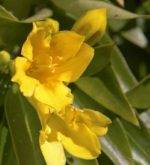 This rapidly growing, climbing or trailing woody vine is evergreen and a member of the logan family, Loganiaceae, a group made up of about thirteen genera many of which are poisonous. It is native from the southeastern seaboard, north to eastern Virginia and west to Texas where it grows in woodlands, fields, fencerows, and thickets but is often grown as an ornamental in both its home range and in southern California. It is the state flower of South Carolina.
This rapidly growing, climbing or trailing woody vine is evergreen and a member of the logan family, Loganiaceae, a group made up of about thirteen genera many of which are poisonous. It is native from the southeastern seaboard, north to eastern Virginia and west to Texas where it grows in woodlands, fields, fencerows, and thickets but is often grown as an ornamental in both its home range and in southern California. It is the state flower of South Carolina.
Paired lanceolate light green leaves are up to four inches long and have smooth margin. They grow on wiry reddish brown stems up to twenty feet long that may climb over shrubs and trees or trail as a three foot tall ground cover. The bright yellow flowers are fragrant, funnel-shaped and about 1.5” long. They appear singly or in clusters in early spring and give way to flattened capsules with winged seeds. The roots, flowers and leaves are poisonous if ingested. Excellent choice for an arbor or trellis. The genus name, Gelsemium, is from gelsomino, the Italian name for the plant. The specific epithet, sempervirens, comes from the Latin words semper being always, and virens, meaning green, and refers to the year-round green color of the foliage.
Type: Evergreen woody flowering vine
Bloom: Bright yellow fragrant, funnel-shaped flowers about 1.5” long in spring
Size: 12-20’ H x 3-6’ W
Light: Full sun but tolerates some shade
Soil: Average, medium moist, well-drained
Hardiness: Zones 7-10
Care: Low maintenance
Pests and Diseases: None of significance
Propagation: Seed, half-ripe wood in summer
Companion Plants: Spring blooming blue flowered plants such as Amsonia, Iris cristata, Phlox divaricata, Sisyrinchium angustifolium, Viola walteri